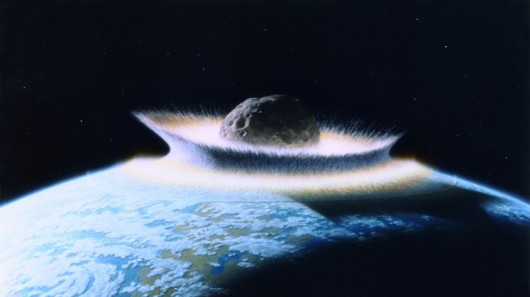Cost-effective laser-based asteroid defense system pitched to NASA
By David Szondy
October 2, 2013
Last year, the University of Strathclyde in Glasgow put forward the idea of using fleets of laser-toting satellites to deflect potentially dangerous objects away from Earth. Now, Dr. Richard Fork, principal investigator for the Laser Science and Engineering Laboratory at the University of Alabama in Huntsville (UAH), and his team have refined the idea, saying that itís not only feasible, but could handle anything up to the size of a comet.
If an asteroid 100 m (330 ft) across hit the Earth, it would be a bad day. The impact of a comet such as Halle-Bopp, which is about 70 km (43 mi) in diameter, would make for a very, very bad day. According to Fork, "[The Hale-Bopp comet] is enormous, and if it had been on a collision course with Earth we would have had only two years from the time it was first observed to the time it arrived at Earth. If the comet happened to be on track to hit us, there would have been nothing we could have done. We would have been toast."
Because of the remote, but still present, danger of such an event happening, finding ways to deflect asteroids is of great interest to scientists and engineers. The idea floated by researchers at Strathclyde University in 2012 involves sending a fleet of small satellites that fires lasers at a potentially dangerous asteroid. The purpose wouldn't be to destroy it in a spectacular Death Star-like explosion, but to nudge it into a new orbit.
Diagram of the laser fleet firing on an asteroid
Instead of one large laser blasting away at a space-going rock, several small ones from the solar-powered satellites would vaporize areas on the asteroid and this vapor and debris would act like a rocket thruster, pushing the asteroid away. The advantages of such a system are, among others, that itís cheaper than ground-based lasers or a laser installed in a large spacecraft. Since itís solar powered, the system would also require much less propellant than a single large space laser and could work at lower wattage than an Earth-based one.
Though similar, the UAH system is based on work started by Dr. Fork at Bell Labs in the 1980s. In the UAH approach, thereís also a fleet of mini satellites, by they are tended by a mothership that that powers the actual laser, which the mini satellites reflect onto the target.
If a threatening asteroid is detected, the satellites are dispatched, perhaps as a unit using an ion drive. On arrival, the mini satellites fan out and orbit the asteroid within a few kilometers. The satellites scan the asteroid and produce a submillimeter-resolution 3D map of the surface, which is constantly updated. This information is used to find flat surfaces that would be an optimal target for the lasers. These areas can be under a millimeter wide.
Dr. Richard Fork says that the proposed system is scalable enough deal with wayward comets
The mothership would supply the lasers, which the minisats reflect onto the asteroid. Coordinated bursts of optical laser blasts would be fired for only picoseconds at a time, vaporizing the rock surface. This may not seem like much, but Fork says that the effect is surprisingly large.
"The amount of average power to be delivered to the asteroid as coherent laser light can be comparable to the power, 10 kilowatts, supplied by the solar system to the currently existing Dawn spacecraft," Fork says.
"One pulse, during the brief time the propulsive force is applied, provides as much power as all three Space Shuttle main engines when they are firing together," continues Fork. "The challenging technical task our group is addressing is that of delivering the required total number of these pulses to an Earth-threatening asteroid so as to apply this highly effective propulsive force efficiently with each delivered pulse.Ē
There was some concern about the debris clouds interfering with the lasers, but the team concluded that these would disperse from the targets areas within three microseconds.
As the lasers are applied, the satellites continue to scan and to plot the asteroidís trajectory; applying the necessary course corrections as needed. The lasers can also be used to make the asteroid stop spinning by strategically firing the lasers, so the debris jets act like the attitude control rockets on a spacecraft.
Presented to NASA because of its cost effectiveness, the system is designed to initially tackle small near Earth objects, specifically ones about 20 m (66 ft) in diameter, which is about the size of the one that exploded over Chelyabinsk, Russia earlier this year. Fork is confident that the technology to build such satellites already exists and itís possible to deflect a small asteroid in the near future. He also says that the proposed system is scalable enough deal with wayward comets, providing enough power can be brought to bear with enough advance warning time.
A paper with the teamís results can be found at the Cornell University Library (PDF)
Source: University of Alabama in Huntsville
Copyright © gizmag 2003 - 2013 To subscribe or visit go to: http://www.gizmag.com
http://www.gizmag.com/cost-effective-laser-based-asteroid-defence-system/29199


